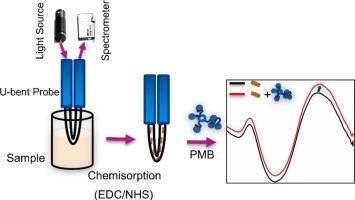用于折射率传感的光纤化学吸收金纳米棒
IF 4.9
Q1 CHEMISTRY, ANALYTICAL
引用次数: 0
摘要
金纳米粒子与光纤的应用已成为开发紧凑、灵敏的生物传感器的一种有前途的方法。在这些纳米结构中,金纳米棒(aunr)由于其局部表面等离子体共振特性而具有明显的优势。虽然以前的研究已经证明了将aunr固定在光纤上用于传感应用,但在实现稳定、一致和无聚集的aunr附着方面仍然存在挑战。在这项工作中,我们提出了一个系统的研究,合成,功能化和化学吸附到氨基功能化的u型弯曲光纤上的aunr。为了解决颗粒聚集和不一致附着的问题,我们对不同浓度的EDC/NHS偶联剂的影响进行了广泛的研究。优化后的条件显著提高了化学吸附的一致性,并使聚集最小化。在不同折射率条件下,研究了固定化aunr的等离子体行为。横向表面等离子体共振(TSPR)的体折射率灵敏度为7∆Abs/RIU。测量时,颗粒浓度为0.2 OD。相比之下,纵向表面等离子体共振(LSPR)峰位置对微环境表现出敏感性,随着多粘菌素B浓度的增加而发生一致的位移,在20 μM处达到1.4%的最大位移。这些结果弥合了aunr功能化和可靠的传感器化学吸附之间的差距,并突出了该平台在医学诊断和环境监测中生物传感应用的潜力。本文章由计算机程序翻译,如有差异,请以英文原文为准。

Chemisorbed gold Nanorods on optical fibers for refractive index sensing
The applicability of gold nanoparticles with optical fibers has emerged as a promising approach for developing compact and sensitive biosensors. Among these nanostructures, gold nanorods (AuNRs) offer distinct advantages due to their localized surface plasmon resonance properties. While previous studies have demonstrated immobilization of AuNRs on optical fibers for sensing applications, challenges remain in achieving stable, consistent, and aggregation-free attachment of AuNRs. In this work, we present a systematic study to synthesize, functionalize, and chemisorb AuNRs onto amine-functionalized U-bent optical fibers.
To address the issue of particle aggregation and inconsistent attachment, we performed an extensive study on the effect of varying concentrations of EDC/NHS coupling agents. The optimized conditions significantly improved chemisorption consistency and minimized aggregation. The plasmonic behaviour of the immobilized AuNRs was characterized under varying refractive indices. The transverse surface plasmon resonance (TSPR) exhibited a bulk refractive index sensitivity of 7 ∆Abs/RIU. The measurement was performed at a particle concentration of 0.2 OD. In contrast, the longitudinal surface plasmon resonance (LSPR) peak position showed sensitivity to the microenvironment, demonstrated a consistent shift with increasing concentrations of Polymyxin B, reaching a maximum shift of 1.4 % at 20 μM. These results bridge the gap between AuNRs functionalization and reliable sensor chemisorption and highlight the potential of this platform for biosensing applications in medical diagnostics and environmental monitoring.
求助全文
通过发布文献求助,成功后即可免费获取论文全文。
去求助
来源期刊

Sensing and Bio-Sensing Research
Engineering-Electrical and Electronic Engineering
CiteScore
10.70
自引率
3.80%
发文量
68
审稿时长
87 days
期刊介绍:
Sensing and Bio-Sensing Research is an open access journal dedicated to the research, design, development, and application of bio-sensing and sensing technologies. The editors will accept research papers, reviews, field trials, and validation studies that are of significant relevance. These submissions should describe new concepts, enhance understanding of the field, or offer insights into the practical application, manufacturing, and commercialization of bio-sensing and sensing technologies.
The journal covers a wide range of topics, including sensing principles and mechanisms, new materials development for transducers and recognition components, fabrication technology, and various types of sensors such as optical, electrochemical, mass-sensitive, gas, biosensors, and more. It also includes environmental, process control, and biomedical applications, signal processing, chemometrics, optoelectronic, mechanical, thermal, and magnetic sensors, as well as interface electronics. Additionally, it covers sensor systems and applications, µTAS (Micro Total Analysis Systems), development of solid-state devices for transducing physical signals, and analytical devices incorporating biological materials.
 求助内容:
求助内容: 应助结果提醒方式:
应助结果提醒方式:


